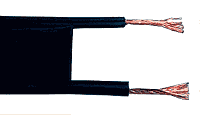
| Part of a series on |
| Antennas |
|---|
 |
Twin lead cable is a two-conductor flat cable used as a balanced transmission line to carry radio frequency (RF) signals. It is constructed of two, stranded copper wires, or solid copper-clad steel wires. The wires are held a fixed distance apart by a plastic ribbon that is a good insulator at radio frequencies (usually polyethylene). It is also called (two wire) ribbon cable. The uniform spacing of the wires is the key to the cable's function as a transmission line: Any abrupt change in spacing would cause some of the signal to reflect back toward the source, rather than passing through. The plastic also covers and insulates the wires. The name twin lead is most often used to refer specifically to 300 Ω (Ohm) ribbon cable, the most common type, but on occasion, twin lead is used to refer to any type of parallel wire line. Parallel wire line is available with several different values of characteristic impedance such as twin lead ribbon cable (300 Ω), window line (300 Ω, 350 Ω, or 450 Ω), and open wire line or ladder line (500~650 Ω).
Twin lead is mainly used as an antenna feedline at shortwave and VHF frequencies, to connect radio receivers and transmitters to their antennas. It can have significantly lower signal loss than miniature flexible coaxial cable, the main alternative type of feedline at these frequencies; for example, type RG-58 coaxial cable loses 6.6 dB per 100 metres (330 ft) at 30 MHz, while 300 Ω twin-lead loses only 0.55 dB.[1] 300 Ω twin lead is widely used to connect FM radios to their antennas, and was previously used to connect television antennas to televisions until it was replaced by coaxial cable. However, it is more vulnerable to interference; proximity to metal objects will inject signals into any type of parallel wire line that would be blocked out by more convenient / more popular coaxial cable. It therefore requires spacing around rain gutters, spaced away from metal fences, exterior wall siding, and metal roofs, and mounted on standoff insulators when run up metal antenna masts.
- ^ "Why ladder line?". zs6hvb.za.net. South Africa: Highveld Amateur Radio Club (ZS6HVB).